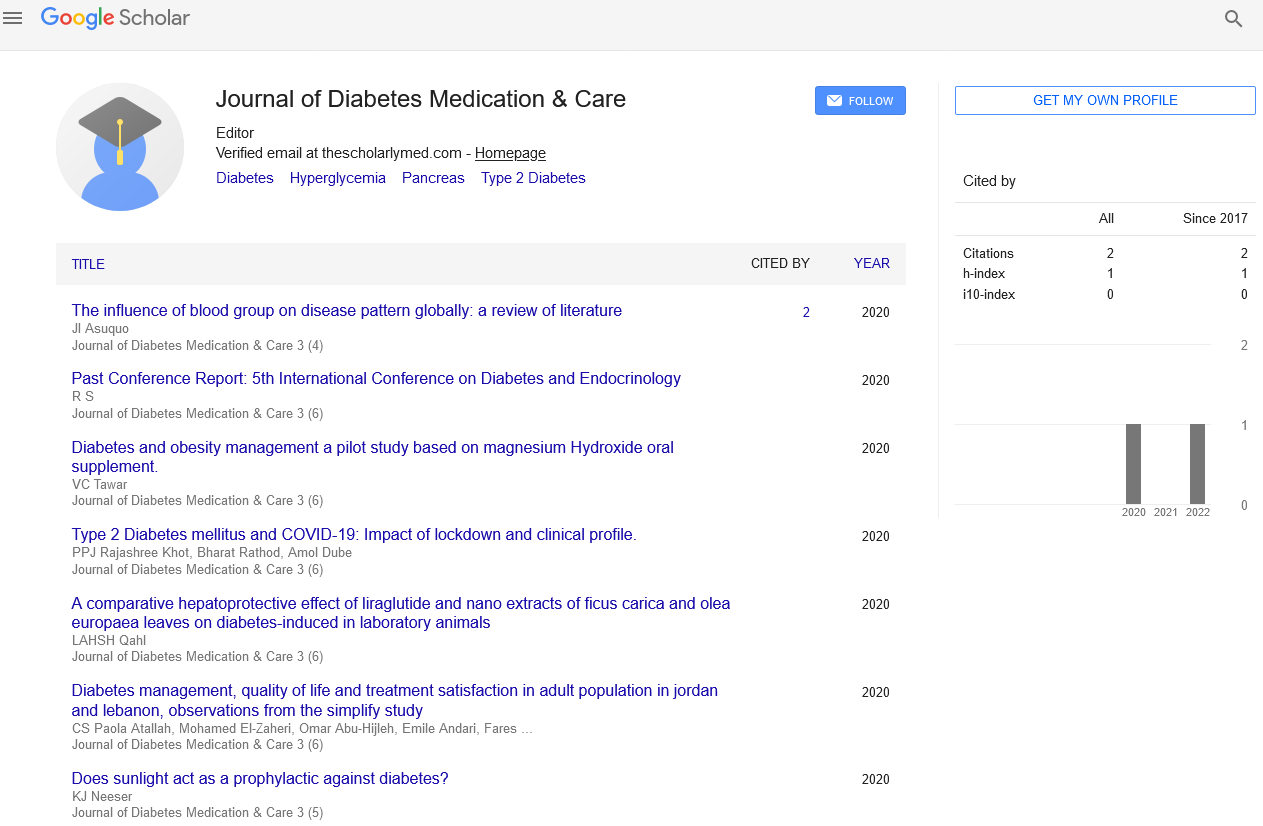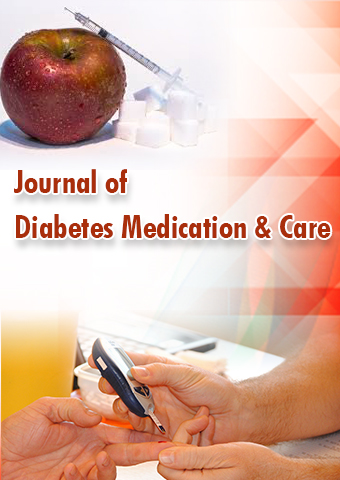Editorial - Journal of Diabetes Medication & Care (2022) Volume 5, Issue 5
Diabetes: Molecular genetics and (Genetic syndromes)
Dr. Khan Kriyaza Ahamd*
Fortis C-DOC Centre of Excellence for Diabetes, Metabolic Diseases, and Endocrinology, Iran
Fortis C-DOC Centre of Excellence for Diabetes, Metabolic Diseases, and Endocrinology, Iran
E-mail: khankriyaza.ahamd@gamil.com
Received: 28-Sep-2022, Manuscript No. JDMC-22-78803; Editor assigned: 01-Oct-2022, PreQC No. JDMC-22-78803; Reviewed: 10-Oct-2022, QC No. JDMC-22-78803; Revised: 17-Oct-2022, Manuscript No. JDMC-22-78803 (R); Published: 28-Oct-2022; DOI: 10.37532/jdmc.2022.5(5).73-75
Abstract
The epidemic nature of diabetes mellitus in different regions is reviewed. The Middle East and North Africa region has the highest prevalence of diabetes in adults (10.9%) whereas, the Western Pacific region has the highest number of adults diagnosed with diabetes and has countries with the highest prevalence of diabetes (37.5%). Different classes of diabetes mellitus, type 1, type 2, gestational diabetes and other types of diabetes mellitus are compared in terms of diagnostic criteria, etiology and genetics. The molecular genetics of diabetes received extensive attention in recent years by many prominent investigators and research groups in the biomedical field. A large array of mutations and single nucleotide polymorphisms in genes that play a role in the various steps and pathways involved in glucose metabolism and the development, control and function of pancreatic cells at various levels are reviewed. The major advances in the molecular understanding of diabetes in relation to the different types of diabetes in comparison to the previous understanding in this field are briefly reviewed here. Despite the accumulation of extensive data at the molecular and cellular levels, the mechanism of diabetes development and complications are still not fully understood. Definitely, more extensive research is needed in this field that will eventually reflect on the ultimate objective to improve diagnoses, therapy and minimize the chance of chronic complications development.
Introduction
Hyperglycemia in pregnancy whether in the form of type 2 diabetes diagnosed before or during pregnancy or in the form gestational diabetes has an increased risk of adverse maternal, fetal and neonatal outcome. Mothers with gestational diabetes and babies born to such mothers have increased risk of developing diabetes later in life. Hyperglycemia in pregnancy is responsible for the increased risk for macrosomia (birth weight ≥ 4.5 kg), large for gestational age births, preeclampsia, preterm birth and cesarean delivery due to large babies. Risk factors for gestational diabetes include obesity, personal history of gestational diabetes, and family history of diabetes, maternal age, polycystic ovary syndrome, sedentary life, and exposure to toxic factors [1].
Diagnosis of type 2 diabetes before or during pregnancy is based on criteria mentioned before [2]. Fasting plasma glucose ≥ 126 mg/dL (7.0 mmol/L) or 2-h plasma glucose ≥ 200 mg/dL (11.1 mmol/L) after a 75 g oral glucose load. However, gestational diabetes has been diagnosed at 24-28 wk of gestation in women not previously diagnosed with diabetes using two approaches: the first approach is based on the “one-step” International Association of the Diabetes and Pregnancy Study Groups (IADPSG) consensus and recently adopted by WHO [3].
Genetic syndromes
Diabetes has been detected in patients with various genetic syndromes such as Down syndrome, Klinefelter syndrome, Turner syndrome and Wolfram syndrome [4].
Molecular genetics of monogenic diabetes
A large array of genes was identified to be involved in the development of monogenic diabetes which represent about 2%-5% of diabetes patients [5]. Monogenic diabetes results primarily from gene defects that lead to a decrease in beta cell number or function. Monogenic diabetes genes were identified using linkage studies or code for proteins that directly affected glucose homeostasis. The majority of genes responsible for monogenetic diabetes code for either transcription factors that participate in the control of nuclear gene expression or proteins that are located on the cell membrane, cytoplasm and endoplasmic reticulum, proteins involved in insulin synthesis and secretion, exocrine pancreatic proteins and autoimmune diabetes proteins. The collective function of these proteins is their participation in glucose metabolism at different levels. Evidently, the hierarchy of a specific gene in the overall glucose metabolism pathway determines the onset of diabetes in the patient and whether it is neonatal expressed or have late onset expression (adulthood). Consequently, molecular defects in the structure and function of these genes lead to the disturbance of plasma glucose level, the primary pathological sign of diabetes. The molecular mechanism of permanent neonatal diabetes mellitus (PNDP) in addition to MODY explains the observed phenotype of monogenetic diabetes that involves loss of function of the expressed mutant protein. The first gene implicated in monogenic diabetes was the glucokinase (GCK) gene which functions as a pancreatic sensor for blood glucose where more than 70 mutations in the gene were identified that affected its activity. A recent study on GCK gene mutations causing neonatal and childhood diabetes showed that the majority of mutations resulted in the loss of the enzyme function primarily due to protein instability. Two hepatocytes nuclear factor genes that code for the HNF4A and HNF1A transcription factors were closely associated with MODY1 and MODY2. Definitely, a whole list of other genes involved in monogenic diabetes are either overlooked or included in the genetic determinants of type 1 and type 2diabetes which will be identified and clarified through more careful future studies [6].
One of the major focuses of biomedical research is to delineate the collective and broad genetic variants in the human genome that are involved in the development of diabetes [7]. Despite the fact that linkage and association studies allowed the identification and characterization of many candidate genes that are associated with type 2 diabetes, however, not all of these genes showed consistent and reproducible association with the disease [8].
Conclusion
Diabetes mellitus is the epidemic of the century and without effective diagnostic methods at an early stage, diabetes will continue to rise. This review focuses on the types of diabetes and the effective diagnostic methods and criteria to be used for diagnosis of diabetes and prediabetes. Evidently, diabetes is a complex disease with a large pool of genes that are involved in its development. The precise identification of the genetic bases of diabetes potentially provides an essential tool to improve diagnoses, therapy (more towards individualized patient targeted therapy) and better effective genetic counseling. Furthermore, our advanced knowledge of the association between medical genetics and the chronic complications of diabetes will provide an additional advantage to delay or eradicate these complications that impose an immense pressure on patient’s quality of life and the significantly rising cost of health-care services.
Acknowledgement
None
Conflict of Interest
None
References
- Kuliev Anver, Verlinsky Yury. Preimplantation diagnosis: A realistic option for assisted reproduction and genetic practice. Curr Opin Obstet Gynecol. 17, 179-83 (2005).
- Williams TN. Obaro SK Sickle cell disease and malaria morbidity: a tale with two tails. Trends in Parasitology. 27, 315-320 (2011).
- Kumar Pankaj, Radhakrishnan Jolly, Chowdhary MA et al. Prevalence and Patterns of Presentation of Genetic Disorders in a Pediatric Emergency Department. Mayo Clinic Proceedings. 76, 777-783 (2001).
- Bick David, Bick Sarah L, Dimmock David P et al. An online compendium of treatable genetic disorders. American Journal of Medical Genetics. Part C, Seminars in Medical Genetics. 187, 48-54 (2021).
- Lvovs D, Favorova OO, Favorov AV et al. A Polygenic Approach to the Study of Polygenic Diseases. Acta Naturae. 4, 59-71 (2012).
- Yoshiura K, Kinoshita A, Ishida T et al. A SNP in the ABCC11 gene is the determinant of human earwax type. Nat Genet. 38, 324-30 (2006).
- Allison AC. Genetic control of resistance to human malaria. Current Opinion in Immunology. 21, 499-505 (2009).
- Perkins BA, Ficociello LH, Silva KH et al. Regression of microalbuminuria in type 1 diabetes. N Engl J Med. 348, 2285-2293 (2003).
Indexed at, Google Scholar, Crossref
Indexed at, Google Scholar, Crossref
Indexed at, Google Scholar, Crossref
Indexed at, Google Scholar, Crossref
Indexed at, Google Scholar, Crossref
Indexed at, Google Scholar, Crossref
Indexed at, Google Scholar, Crossref

